朗文语音四级第五次课教案
朗文少儿英语教案 Unit5阅读课,活动课

LEW 2A-U5 About meThe first-reading 1. T: Here is a worksheet. Listen to the video and finish the worksheet. But you can’t open your book.2.Now, open your book and check your answer. After checking your answer, finish the table on P27. (小组PK对答案, S: Kelly lives in Macau. She goes to school by motorcycle)second reading- shared reading Picture talking:T: Children, look. This is Kelly. They are very happy. Who is he? Who takes Kelly to school?②T: Children, who is he? (指着男孩) Who takes him to school?③Now,look at the Big Ben. Where does Dan live? Why does he go to school by bicycle?④指着自由女神像问:Do you know where it is? What colour is the school bus? What colour is your school bus?⑤How does Maha call the boat? Do you want to try?Second reading: reading aloud Listen and imitate. And I will choose the best one.(注意语音语调的模仿)1.The whole class2.Boys VS. GirlsPost reading:1.role play (表演时需配上相应的肢体动作)T: These are the headwears of each place. When you choose Thailand, you will become Maha and introduce yourself. Who wants to try?Five points.2、Who can talk about more students in the website?(两分钟准备,然后合上书,每个人选择PPT上的数字,选1 看图片描述1个人,选2描述看图片2个人)Test 1. Dictation (words and sentences)2. Reading match:Please imitate the story and let’s see which group can read it in a correct intonation.Dialogue activity 1.Number game(practice 1)两人一组,然后掷骰子,抛到相应的数字就要表达相应的对话Listening 听力练习册P18&P19Homework 1.根据上节课的调查结果完成一本题目为About me的故事集(作文加配图)2.打卡课本内容三次3.配音。
朗文4AChapter5教案
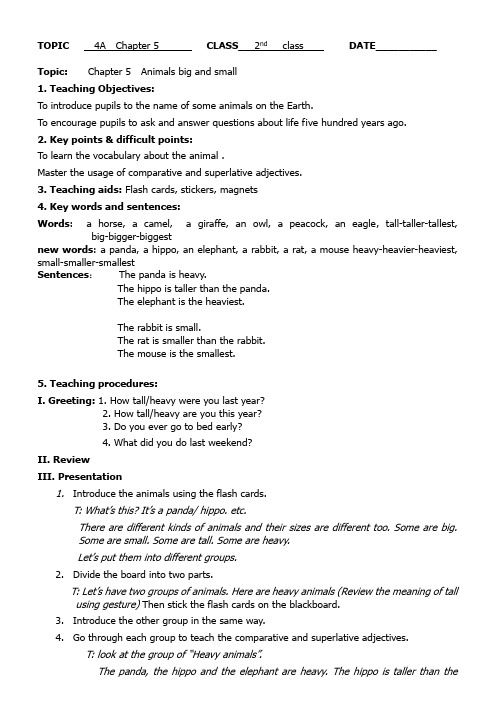
TOPIC 4A Chapter 5_____ CLASS___2nd class_ DATE___________Topic:Chapter 5 Animals big and small1. Teaching Objectives:To introduce pupils to the name of some animals on the Earth.To encourage pupils to ask and answer questions about life five hundred years ago.2. Key points & difficult points:To learn the vocabulary about the animal .Master the usage of comparative and superlative adjectives.3. Teaching aids: Flash cards, stickers, magnets4. Key words and sentences:Words: a horse, a camel, a giraffe, an owl, a peacock, an eagle, tall-taller-tallest, big-bigger-biggestnew words: a panda, a hippo, an elephant, a rabbit, a rat, a mouse heavy-heavier-heaviest, small-smaller-smallestSentences:The panda is heavy.The hippo is taller than the panda.The elephant is the heaviest.The rabbit is small.The rat is smaller than the rabbit.The mouse is the smallest.5. Teaching procedures:I. Greeting: 1. How tall/heavy were you last year?2. How tall/heavy are you this year?3. Do you ever go to bed early?4. What did you do last weekend?II. ReviewIII. Presentation1.Introduce the animals using the flash cards.T: What’s this? It’s a panda/ hippo. etc.There are different kinds of animals and their sizes are different too. Some are big.Some are small. Some are tall. Some are heavy.Let’s put them into different groups.2.Divide the board into two parts.T: Let’s have two groups of animals. Here are heavy animals (Review the meaning of tall using gesture) Then stick the flash cards on the blackboard.3.Introduce the other group in the same way.4.Go through each group to teach the comparative and superlative adjectives.T: look at the group of “Heavy animals”.The panda, the hippo and the elephant are heavy. The hippo is taller than thepanda.The elephant is the heaviest.5. Use different coloured chalk to emphasize different parts of an adjective when writing outthe sentences on the board. Teach pupils how to change the adjectives, eg.heavy-heavier-heaviest, small-smaller-smallest6.Open Longman book P33 ask the pupils to read the sentence.7.Game:(1)Spin the Bottle: Sit Ss in a circle with a bottle in the middle. T Spins the bottle. When it stops spinning the S , he/she need to make two sentence. (T will give he/she an adj. eg:( small. The rat is smaller than the rabbit. The mouse is the smallest.)(2)Sentence Chain: have the Ss to sit with T in a circle. T says a word (or sentence)and then the next S repeats that word and adds a new word. S2 then says the 2 words and adds another. Continue going around the circle until the list gets too long to remember!8. Exercise: Ask pupils to finish Oral Book p.2 Exercise 2.9. Get pupils to work in pairs and talk about the animals and birds. Go round the class checking their understanding and the use of the adjectives.IV. Homework:Ask pupils to finish Oral Book p.2 Exercise36. Blackboard Design:7. Teachers’ Summary & Notes:。
新四第五课课件

In fact/ actually 的升级版
• If the truth be told,…
• The truth lies somewhere closer to the fact that… • Let us get down to fundamentals and agree that…
Text
Exercise
• In light of the technological route that education is on today there has been some speculation as to the role of teachers in future education. To what extent do you think teachers are being replaced by computers? • Computer is just a teaching tool.
The problem/rub is…
ቤተ መጻሕፍቲ ባይዱ
Text
Being a problem gives you a certain identity.
upgrade
If sb do sth…, sb can do…
Extension
• Knowing which side of the fence your potential business partner sits on will (allow you to) prioritize your presentation and give you a fair estimate of the time frame needed for closing a potential deal. • If you do sth…, you can… • Relationship-driven culture • Task-driven culture
英语五上5A Unit 4 (5)教案
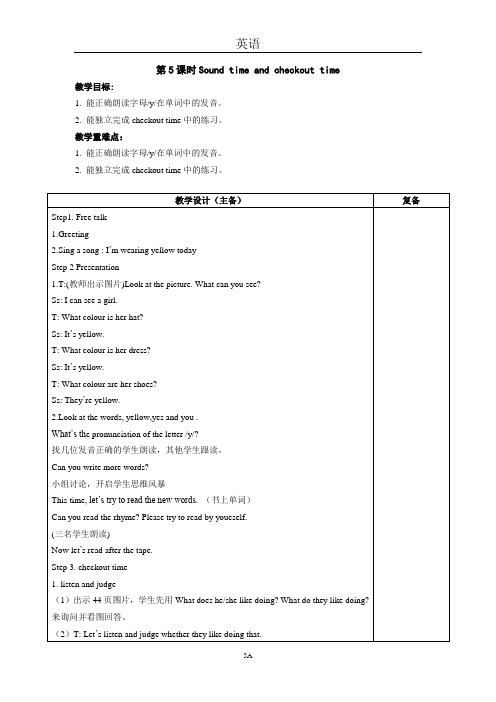
And yellow dress.
找几位发音正确的学生朗读,其他学生跟读。
Can you write more words?
小组讨论,开启学生思维风暴
This time, let’s try to read the new words.(书上单词)
Can you read the rhyme? Please try to read by youeself.
(三名学生朗读)
Now let’s read after the tape.
Step 3. checkout time
1.listen and judge
(1)出示44页图片,学生先用What does he/she like doing? What do they like doing?来询问并看图回答。
第5课时Sound time and checkout time
教学目标:
1.能正确朗读字母/y/在单词中的发音。
2.能独立完成checkout time中的练习。
教学重难点:
1.能正确朗读字母/y/在单词中的发音。
2.能独立完成checkout time中的练习。
教学设计(主备)
复备
Step1. Free talk
Step 4. Exercise (练习与测试40页)
Think d write
Homework:
Review Unit4
板书设计:
Unit1hobbies
y /j/ year yellow yes you young
Do you like wearing yellow?
Yellow ? Yellow? Yes!
朗文少儿英语教案 5A U2
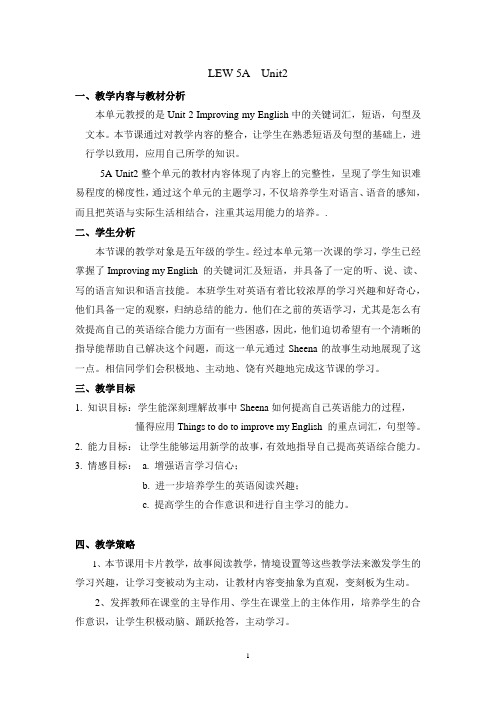
故事中Genie的出现起什么作用以及对Genie的语音语调的模仿是难点。
Teaching materials:PPT, flash cards, e book, word cards
Teaching steps:
Step1. Warm-up
1.Fast review last lesson’s key words and phrasesby usingcards to arouse the students’interest.
(设计意图:用单词卡片游戏的方式和同学们热身,同时起到复习上次课重点知识的作用)
2. Lead-in:Ask questions about how to improve our English and introduce a friend‘Sheena’to students.
(设计意图:通过设问如何提高自己的英语能力去促进同学们思考,同时介绍Sheena这个小朋友,从而引入本课主题)
(设计意图:同学们上台用英语分享他们所想到的办法。
同学们在想办法和讲述的同时自己也就明白了怎么样提高英语)
Step5.1. Summarize key phrases and structures.
2. How to improve our English
(设计意图:帮同学们快速复习和总结本课的重点)
3、巧妙采用“帮朋友解决问题”的形式 Nhomakorabea为课堂的Post-reading Part,能调动学生的积极性,激发学生的学习热情,启发学生学以致用。
五、教学流程图
六、具体教学过程
Key points:
学生能理解故事中Sheena提高自己英语能力的过程中都做了些什么,是怎么做的,能够运用新学的故事,明白自己和朋友想提高英语综合能力应该怎么做。
(完整版)香港朗文Chapter5教案

Chapter 5 Signs we seePeriod 1一、Teaching contents:《International Edition Longman Welcome to English》Chapter5 Signs we see Part ALanguage Knowledge:To know and to use “Don’t ….” to talk about some signs commonlyseen in the park, in the school and relevant rules.二、Teaching aims1. Aims of knowledgea. To introduce pupils to signs commonly seen in the park and the relevant rules.b. To teach pupils the use of imperatives to express prohibitions.cook(n.),dentist, doctor, fire, fireman, housewife, job, nurse, policeman, policewoman, waiter, waitress2. Aims of abilitiesa. To obtain and provide information in simple classroom situations through activities such as interactive games and role-play.b. To provide or find out and present simple information on familiar topics.3. Aims of emotiona. Like to speak English and to communicate with others. To know the rules what we should follow in our life.三、Difficult and key pointsKey points:a.Pupils learn the names of rules in different situations.b.They also learn to ask and answer questions about the commonly rules in dailylife.Difficult points:a. To introduce pupils to rules of different situations.四、Teaching aids1. flash cards2. PPT五、T eaching procedure:Step 1. Warm-up1. Make greetings2. Warm-up activities.3. Talk with the studentsStep2. Presentation1.Show a picture of park to the pupils to talk about. (CAI)2. Introduce a flash to pupils to talk about what they can not do in the park: Don’t pick the flowers. / Don’t walk on the grass. …1. Present the E-book Part A, Chapter 52. Ask pupils to read in the different ways.(1). Ask pupils to read after the E-book.(2). Ask pupils to read after the teacher.(3). Ask pupils to read by themselves.3. Have a role-play: ask pupils to act put the play.4. Present the E-book Part B, Chapter5.1. Introduce a Video about pupils’ life in the school.2. Ask pupils to express their own opinions about the video.1.Enjoy a video.2 Express their own opinions that things can not do in school .5. Introduce pupils to park. Draw objects in the park and write captions as you ask pupils questions.T: Do you know what a park is? Have you ever been to a park?What can you see in a park?What’s this?S: It’s a flower.T: What’s this?S: It’s a tree.T: What’s this?S: It’s grass. Grass is pretty. It’s green.T: What else can you see in the park? Birds. Very good. You can see birds in the park.Sometimes you can see other animals in the park too. What animals?Step3. Practice1. Read and listen Part A & B, Chapter5.2. Find 3 signs that commonly seen in the life and draw on paper.六、Homework1. Follow the CD read part A2. Use the word cues on the board to make sentences.七、 Blackboard writing八、Reflection after class:Chapter 5 Signs we seePeriod 2三、Teaching contents:《International Edition Longman Welcome to English》Chapter5 Signs we see Part BLanguage Knowledge:To know and to use “Don’t ….” to talk about some signs commonlyseen in the park, in the school and relevant rules.四、Teaching aims1. Aims of knowledgea. To introduce pupils to signs commonly seen in the park and the relevant rules.b. To teach pupils the use of imperatives to express prohibitions.cook(n.),dentist, doctor, fire, fireman, housewife, job, nurse, policeman, policewoman, waiter, waitress2. Aims of abilitiesa. To obtain and provide information in simple classroom situations through activities such as interactive games and role-play.b. To provide or find out and present simple information on familiar topics.3. Aims of emotiona. Like to speak English and to communicate with others. To know the rules what we should follow in our life.三、Difficult and key pointsKey points:c.Pupils learn the names of rules in different situations.d.They also learn to ask and answer questions about the commonly rules in dailylife.Difficult points:a. To introduce pupils to rules of different situations.四、Teaching aids1. flash cards2. PPT五、T eaching procedure:Step 1. Warm-up1. Make greetings2. Warm-up activities.3. Talk with the studentsStep2. Presentation1. Good morning class! Good morning. What’s t he weather like today? What day is it today?2. Talk about the rules in the park. Use the flash cards. Point to the line across the signs and repeat don’t.T: What can you do in the park? You can play there.But there are some things we can’t do in the park. Look at these signs in the park. They tell us what we can’t do.Here’s a sign. Climb the trees. We can’t climb the trees. Don’t climb the trees. What else can’t we do in the park?Pick the flowers. Very good. We can’t pick the flowers.S: Don’t pick the flowers.T: What other signs can you see?S: Feed the animals. We can’t feed the animals. Don’t feed the animals.3. Write the relevant rules underneath the signs. Go through the rules one by one with pupils. Find rub out the words and ask pupils to tell you the rules.T: What does Sign 1 mean?P: It means “Don’t climb the trees.Step3. Practice1. Let the Ss talk with their partner and do the Part B together.2. Check the answer3. Work in pairs.4. Act conversation5. Use the sentences they have learned instead of the text.Step 4 Homework1. Recite Part A.2.Act the Part B to your parents七、 Blackboard writing八、Reflection after class:Chapter5 Signs we see (Period3)一、Teaching contents:《International Edition Longman Welcome to English》Chapter5 Signs we see Part C&D二.Teaching aims:1. Aims of the knowledge:a.. To develop pupil’s reading skills and stimulate their critical thinking ability.b. .To teach the/ a / sound for the letter o.c. To interpret and use simple given information through process or activities such as labeling ,matching, sequencing, describing, classifying; and to follow simple instructions.d. To recognize some obvious features of the English Language in simple spoken and written texts such as the direction of writing in English ,the characteristics of an alphabetic script and the sound patterns of English ; and apply this awareness to one’s initial learning and use of the language.e. To provide or find out and present simple information on familiar topics.2. Aims of the abilities:a. To recognize some obvious features of the English Language in simple spoken and written texts such as the direction of writing in English ,the characteristics of an alphabetic script and the sound patterns of English ; and apply this awareness to one’s initial learning and use of the language.b. To provide or find out and present simple information on familiar topics.3. Aims of the emotion:1.Appreciative with respect for others.三.Difficult and key points:a. Pupils can understand the text.b. Pupils can read the text by themselves.c. Pupils can answer teacher’s question.d. Pupils can do the Part D by themselves.四.Teaching aidsFlash card, CD, super E-book五.Teaching ProcedureStep1.Warm-upGreet to pupilsWarm-up activities.Talk with the Ss.Step 2.Presentation1.Arouse pupil’s interest in reading by asking one or two questions about the story.What place is this?What animals can you see?2.Pre-teach any new words, e.g hungry, bananas, yummy, full.3.Tell pupils to read the story once silently.4.Ask questions about the story.In picture2,what does the monkey want?S: Bananas.In picture4 can people feed the monkey?S: Yes.T: Why?S: The signs says: Feed the animals.T: Do the monkeys like the food,What do they say?(Yes, this fruit’s yummy.)In picture 6 why aren’t the monkeys hungry?S: Because they eat the bananas, they’re full.5.Get pupils to act the story in groups. Ask one or two groups with lively intonationand reasonably accurate pronunciation to come to the front to perform.6.Check pupil’s answer to Part D.Step3. Practice1. Read the text2 .Let them have a role play.Step4. Production1.Tell Ss to get into group of four to six practice the text.2.T and Ss find the skills.六. Homework1. Read part C and try to recite it.七.Blackboard writing八. Reflection after classChapter5 Signs we see (Period4)一.Teaching contents:《International Edition Longman Welcome to English》Chapter5 Signs we see Part E二. Teaching aims:1. Aims of the knowledge:a. To get pupils to practice using questions previously learnt to ask for each other’s personal information.b. To obtain and provide objects and information in simple classroom situations and through activities such as interactive games and role-playc. To interpret and use simple given information through processes or activities such as labeling, matching, sequencing, describing, classifying; and to follow simple instructions2. Aims of the abilities:a.To establish and maintain relationships and routines in carrying out classroom activities.b. To get pupils to practice talking with others.c. Let the Ss find out more about others.3. Aims of the emotion:Appreciative with respect for rules三.Difficult and key points:a. T o get pupils to practice using questions previously learnt to ask for each other’s personal information..b. To get pupils to practice talking about more about the rules in the real situation.四. Teaching aidsFlash card , CD , super E-book五 Teaching ProcedureStep 1. Greetings1. Greet to pupils2. Warm-up activities.3. Talk with the Ss.Step 2. Presentation1.Hello, class! Good morning.Nice to meet you.What’s the weather like today?What day is it today?2.Revise the use of can and can’t to express obligations and prohibitionsWe can read in the classroom.What else can we do here? We can sit in the classroom. Yes., that’s right.Can we play in the classroom? No, we can’t. We can’t play in the classroom.3.Tell pupils that signs tell us rules. They often start with Do not…4.In pairs, pupils act Alan and Tim. They talk about the signs on their way throughthe park.5.Check pupil’s answers to Part E.6.Tell pupils to think of rules for the classroom and make signs.7.What signs can we make for classroom?8.Don’t draw on the board. Don’t sit on the floor.9.Can you think of any other signs? Etc.Step3. Practice:1.Give Ss 3 minutes let them talk with their partners by using the sentences theyhave learned.2.Tell Ss to find out more information about the rules in the real situation.3.Step4 Homework1. Read part E and try to recite it .2. Find out more information about their parents.六. Blackboard writing七. Reflection after classChapter5 Signs we see (Period5)一.Teaching contents:《International Edition Longman Welcome to English》Chapter5 Signs we see Part F & Phonics二.Teaching aims:1.Aims of the knowledge:a. To enable pupils to enjoy and appreciate the English Language through saying a simple rhyme.b. To interpret and use simple information through processes or activities such as labeling, matching, sequencing, describing , classifying; and to follow simple instructions .c. To recognize some obvious features of the English Language in simple spoken and written texts such as the direction of writing in English , the characteristics of an alphabetic script and the sound patterns of English ; and apply this awareness to one’s initial learning and use of the language .d. To develop an awareness and an enjoyment of the basic sound patterns of English in imaginative texts through activities such as participating in action rhymes, singing songs and choral speaking.e. Vowel sound: cl ,fl2. Aims of the abilities:a. To provide or find out and present simple information on familiar topics.b. To recognize some obvious features of the English language in simple spoken and written texts such as the direction of writing in English, the characteristics of an alphabetic script and the sound patterns of English; and apply this awareness to one’s initial learning and use of the language.c. To interpret and use simple given information through processes or activities such as labeling, matching, sequencing, describing, classifying; and to follow simple instructions3 .Aims of the emotion:To enable pupils to enjoy and appreciate the English Language through reading rhyme.三.Difficult and key points:1. To grasp the sound:2. Pupils can use the sentence to ask about the jobs.四.Teaching aidsFlash card , CD , super E-book五.Teaching procedureStep1.Warm-up1. Greet to pupils2. Warm-up activities.3. Talk with the SsStep 2 Presentation1. Hi, class! Good morning.Nice to see you.What’s the weather like today? What day is it today?Get pupils to look at your mouth while you pronounce the/ ɔ / sound orplay the video in the super E-Book.Look at my mouth .Say after me.3. Play the phonics game in the Super E-Book.4. Ask pupils if they know the similarity between the words climb and classroom. Tell them that the words have the same beginning sound. Do the same with the other two words(flower and fly).5. Check pupil’s pronunciation of the /kl/ and /fl/ cleans the classroom floor.6. Ask pupils to say other known words with the same sound.7. Read out the poem and tell pupils to listen carefully.8. Explain any words or expressions which pupils may find difficult to understand.9. Pupils read the lines of the poem after you. Try to ensure the chanting does not become too slow or expressionless.10. Invite pupils to read out the poem in groups or individually for the whole class. Give encouragement and recognition for their performance.Step3.Practice1. Let the Ss talk with their partner how to read the rhyme. Let each of a group come to the board to have a competition ,who is better, I will give a star )Step4. PracticeTell Ss to find out more information about the /cl/ /fl/Work in pairsStep5. Homework1. Read part F .2. Act the part F to your parents七. Blackboard writing。
四级五级教案模板范文
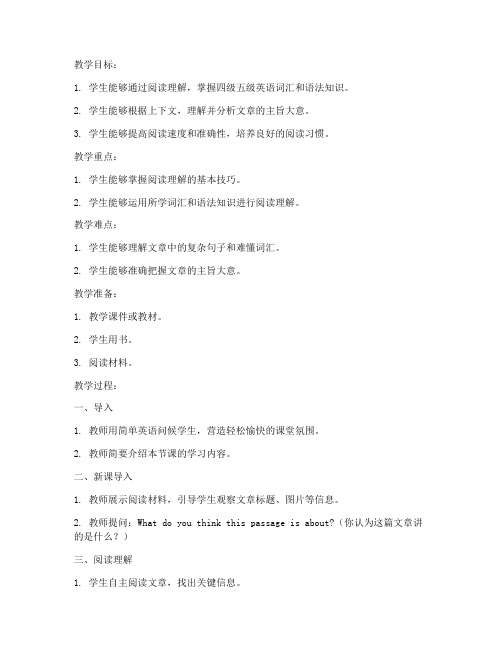
教学目标:1. 学生能够通过阅读理解,掌握四级五级英语词汇和语法知识。
2. 学生能够根据上下文,理解并分析文章的主旨大意。
3. 学生能够提高阅读速度和准确性,培养良好的阅读习惯。
教学重点:1. 学生能够掌握阅读理解的基本技巧。
2. 学生能够运用所学词汇和语法知识进行阅读理解。
教学难点:1. 学生能够理解文章中的复杂句子和难懂词汇。
2. 学生能够准确把握文章的主旨大意。
教学准备:1. 教学课件或教材。
2. 学生用书。
3. 阅读材料。
教学过程:一、导入1. 教师用简单英语问候学生,营造轻松愉快的课堂氛围。
2. 教师简要介绍本节课的学习内容。
二、新课导入1. 教师展示阅读材料,引导学生观察文章标题、图片等信息。
2. 教师提问:What do you think this passage is about?(你认为这篇文章讲的是什么?)三、阅读理解1. 学生自主阅读文章,找出关键信息。
2. 教师指导学生使用阅读技巧,如扫读、略读等。
3. 学生分享阅读心得,教师进行点评。
四、词汇学习1. 教师带领学生分析文章中的重点词汇和短语。
2. 学生用所学词汇造句,巩固词汇。
五、语法学习1. 教师讲解文章中的语法知识,如时态、语态等。
2. 学生进行相关练习,巩固语法知识。
六、总结与拓展1. 教师总结本节课的学习内容,强调阅读理解技巧。
2. 学生分享自己在阅读过程中的收获和感悟。
3. 教师布置课后作业,要求学生阅读相关材料,提高阅读能力。
教学反思:1. 教师要关注学生的阅读理解能力,及时调整教学策略。
2. 在教学过程中,注重培养学生的自主学习能力,提高阅读兴趣。
3. 通过多种教学手段,激发学生的学习热情,提高教学效果。
教学时间:1课时教学评价:1. 学生能够掌握阅读理解的基本技巧,提高阅读速度和准确性。
2. 学生能够运用所学词汇和语法知识进行阅读理解。
3. 学生对阅读材料产生兴趣,养成良好的阅读习惯。
朗文英语4A Chapter 5课件

Practice
table tennis match
tennis match
football match
Amy watched some exciting matches.
The tennis match was more exciting than the table tennis match.
The Great Wall was the most interesting.
the beach
the garden
the island
Dad visited some beautiful places. The garden was more beautiful than the beach. The island was the most beautiful.
All adjectives of three syllables or more
Examples
Mary is more polite than Cindy. Tom is more helpful than Peter.
Candy is more hard-working than Maggie. Joe is more good-looking than Tom.
Part F
Bring in your holiday photos and talk about them with your friends.
THE END
story?
At the beach. The jungle and the mountains. On the highest mountain. It felt tired.
Part E
Mount Fuji, Japan
新目标七年级上册英语Unit4第5课时教案
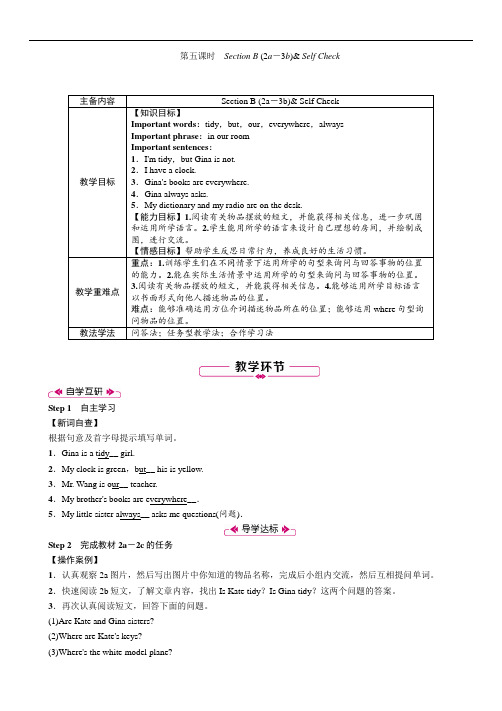
第五课时Section B(2a-3b)& Self Check主备内容Section B (2a-3b)& Self Check教学目标【知识目标】Important words:tidy,but,our,everywhere,alwaysImportant phrase:in our roomImportant sentences:1.I'm tidy,but Gina is not.2.I have a clock.3.Gina's books are everywhere.4.Gina always asks.5.My dictionary and my radio are on the desk.【能力目标】1.阅读有关物品摆放的短文,并能获得相关信息,进一步巩固和运用所学语言。
2.学生能用所学的语言来设计自己理想的房间,并绘制成图,进行交流。
【情感目标】帮助学生反思日常行为,养成良好的生活习惯。
教学重难点重点:1.训练学生们在不同情景下运用所学的句型来询问与回答事物的位置的能力。
2.能在实际生活情景中运用所学的句型来询问与回答事物的位置。
3.阅读有关物品摆放的短文,并能获得相关信息。
4.能够运用所学目标语言以书面形式向他人描述物品的位置。
难点:能够准确运用方位介词描述物品所在的位置;能够运用where句型询问物品的位置。
教法学法问答法;任务型教学法;合作学习法Step 1自主学习【新词自查】根据句意及首字母提示填写单词。
1.Gina is a tidy__ girl.2.My clock is green,but__ his is yellow.3.Mr. Wang is our__ teacher.4.My brother's books are everywhere__.5.My little sister always__ asks me questions(问题).Step 2完成教材2a-2c的任务【操作案例】1.认真观察2a图片,然后写出图片中你知道的物品名称,完成后小组内交流,然后互相提问单词。
Unit4_第5课时教学设计(4)
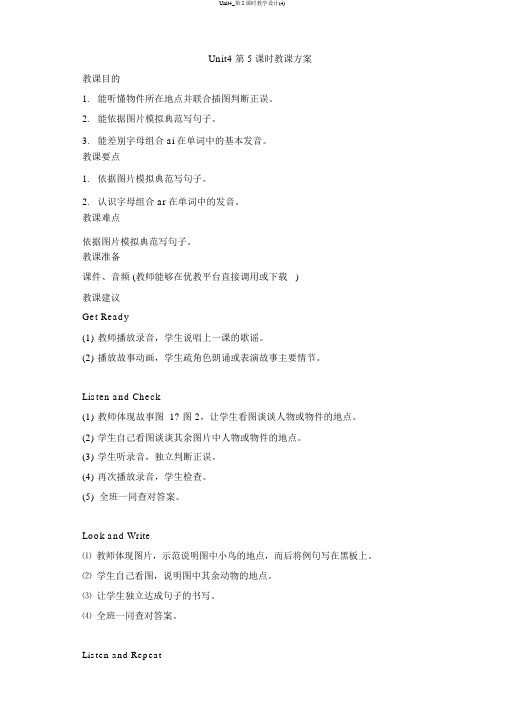
Unit4 第 5 课时教课方案教课目的1.能听懂物件所在地点并联合插图判断正误。
2.能依据图片模拟典范写句子。
3.能差别字母组合 ai 在单词中的基本发音。
教课要点1.依据图片模拟典范写句子。
2.认识字母组合 ar 在单词中的发音。
教课难点依据图片模拟典范写句子。
教课准备课件、音频 (教师能够在优教平台直接调用或下载 )教课建议Get Ready(1)教师播放录音,学生说唱上一课的歌谣。
(2)播放故事动画,学生疏角色朗诵或表演故事主要情节。
Listen and Check(1)教师体现故事图 1? 图 2,让学生看图谈谈人物或物件的地点。
(2)学生自己看图谈谈其余图片中人物或物件的地点。
(3)学生听录音,独立判断正误。
(4)再次播放录音,学生检查。
(5)全班一同查对答案。
Look and Write⑴ 教师体现图片,示范说明图中小鸟的地点,而后将例句写在黑板上。
⑵ 学生自己看图,说明图中其余动物的地点。
⑶ 让学生独立达成句子的书写。
⑷ 全班一同查对答案。
Listen and Repeat(1)教师能够将本板块中的这几个单词串成一个故事,在讲故事、学生猜想情节发展的过程中出示图卡和词卡,带读单词。
教师体现一个小男孩的图片,告诉学生他叫Mark。
让学生看他的手臂受伤了(体现词卡 arm)。
让学生听汽车的声音,猜单词(体现词卡 car)。
告诉学生 Mark 搭车去了很多地方。
Mark 先去了农场,教师体现农场一角(体现词卡 farm), 而后他又去了公园(体现词卡 park)。
接下来, Mark 在公园里看表演,一个魔术师拿着一个星形(体现词卡 star)和心形(体现词卡 heart)的魔杖,在水中变出了一条鲨鱼(体现词卡 shark)。
(2)教师指单词,和学生一同朗诵。
让学生注意暗影标出的字母组合 ar/ear在单词中的发音,能够让学生试着说出发音。
(3)教师体现短文,让学生边读边标出字母组合 ar 发音与 arm 同样的单词。
E英语教程4 Unit 5
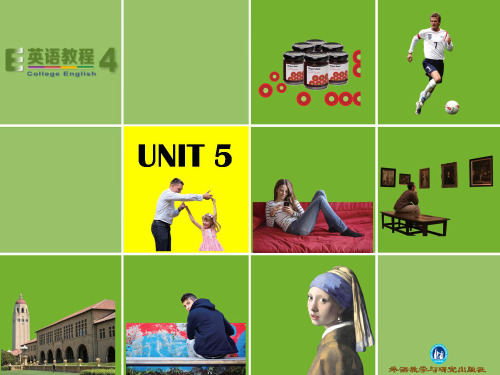
Situation 1
(Sample)
Situation 2
(Sample)
B failed an exam because he / she skipped too many classes this term. He / She asks A, his / her parent, to forgive him / her.
Conversation 1
– Expressing regret & responses
3. Role-play a conversation in pairs according to one of the following situations. You may refer to the Functional Language.
Content
Listening and speaking Reading Grammar Writing Culture express
Listening and spend listening skills Conversations Passage
2 No? You don’t seem to be ______________ as cheerful as you normally are. Are you sure you are OK? I really regret doing it If only I 3 I know it’s my fault. ___________________ had studied harder, but… but… learn from your 4 I believe you. I just hope you can__________________ mistake ________.
【吉林】4(第5课时)教案(新版)人教新目标版
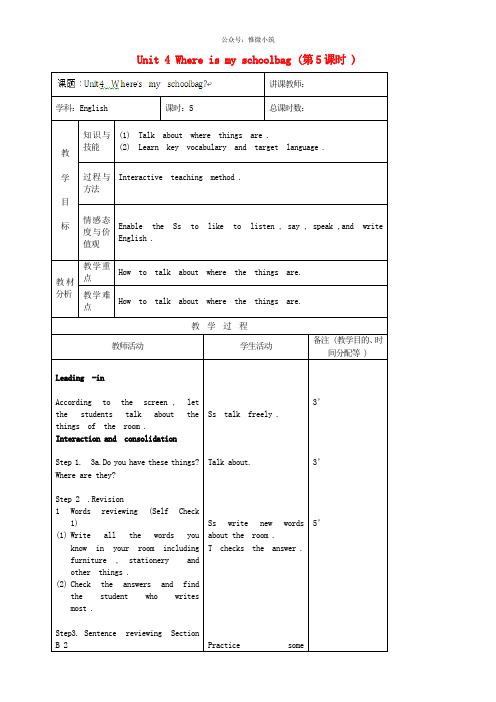
Unit 4 Where is my schoolbag (第5课时 )讲课教师:学科:English 课时:5 总课时数:教学目标知识与技能(1) Talk about where things are .(2) Learn key vocabulary and target language .过程与方法Interactive teaching method .情感态度与价值观Enable the Ss to like to listen , say , speak ,and writeEnglish .教材分析教学重点How to talk about where the things are.教学难点How to talk about where the things are.教学过程教师活动学生活动备注 (教学目的、时间分配等 )Leading -inAccording to the screen , letthe students talk about the things of the room .Interaction and consolidationStep 1. 3a.Do you have these things? Where are they?Step 2 .Revision1Words reviewing (Self Check1)(1)Write all the words youknow in your room including furniture , stationery and other things .(2)Check the answers and findthe student who writes most .Step3. Sentence reviewing Section B 2 Ss talk freely .Talk about.Ss write new words about the room .T checks the answer . Practice some3’3’5’。
英语四年级上册 Unit4 Lesson5教案
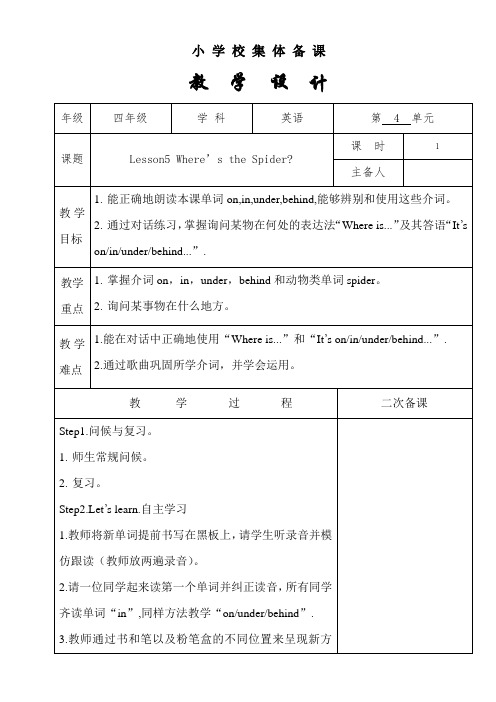
教 学
第4单元
课题
Lesson5 Where’s the Spider?
课 时
1
主备人
教学目标
1.能正确地朗读本课单词on,in,under,behind,能够辨别和使用这些介词。
2.通过对话练习,掌握询问某物在何处的表达法“Where is...”及其答语“It’s on/in/under/behind...”.
Step4.Let’s talk.
1.听录音,回答问题。
How many people are there in the conversation?
What did they see? Where is the spider?
Who is afraid of the spider?
2.朗读对话。
3.角色扮演。
Step3.教学句型“Where is...”及其答语“It’s...”.
1.教师出示画有物体及其所在方位的图,如在课桌上的书包、在椅子后面的笔、在箱子中的玩具车、在床下的课本的图,给学生看10秒钟,随后收起来并提问,如“Where is the pen?”学生尝试说出答案。
2.游戏:大搜索。
教师出示一张画有许多表示物体方位的挂图,问“Where is...”,让学生迅速找出相应物品,看谁找得最快。
1.师生常规问候。
2.复习。
Step2.Let’s learn.自主学习
1.教师将新单词提前书写在黑板上,请学生听录音并模仿跟读(教师放两遍录音)。
2.请一位同学起来读第一个单词并纠正读音,所有同学齐读单词“in”,同样方法教学“on/under/behind”.
3.教师通过书和笔以及粉笔盒的不同位置来呈现新方位介词的中文意思。教师可通过出示卡片等方式,采用教师领读,学生朗读等手段,确保学生发音准确。
少儿英语课件 朗文 5AU4录像课教案
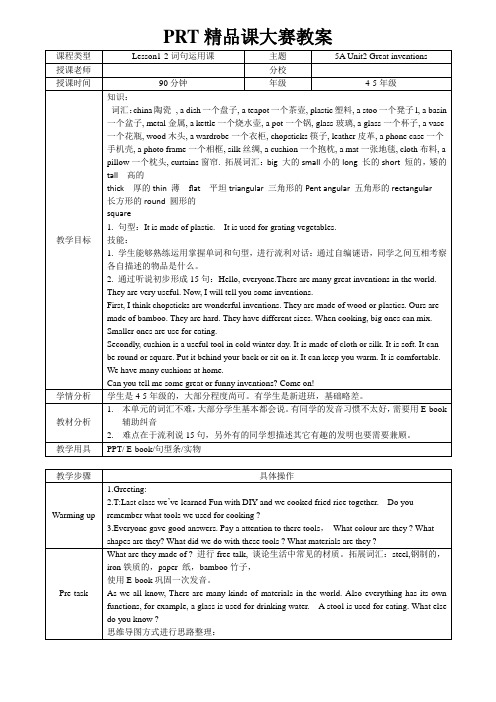
PRT精品课大赛教案
While-task 1.展示E-book. 再次复习.第一遍请某一个同学先读其中单词,并把有疑问的单词做标记后请同学们自主拼读发表意见,最后跟读E-book并判断正误,给回答正确的同学加分奖励。
Game:随机指教室以及准备的实物部分请同学抢答,快而准确组得分。
2.句型部分:
实物展示, It is a spoon. We use it a lot in our life. It is made of plastic and metal. Smaller ones are used for having soup. Big ones are used for cooking.
展示句型条:
It is made of plastic and metal.
It is used for having soup.
Game:把实物放在一起,分组后请同学为对方组指定物品,做描述。
描述出一个特点就可以得一分,多个特点多分制。
香港朗文2Bchapter4教案第五课时
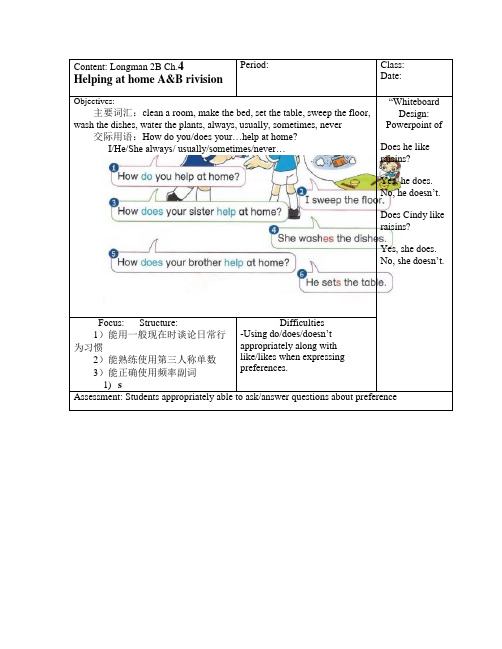
Content: Longman 2B Ch.4 Helping at home A&B rivision Period: Class:Date:Objectives:主要词汇:clean a room, make the bed, set the table, sweep the floor, wash the dishes, water the plants, always, usually, sometimes, never 交际用语:How do you/does your…help at home?I/He/She always/ usually/sometimes/never…“WhiteboardDesign: Powerpoint ofDoes he like raisins?Yes, he does. No, he doesn’t. Does Cindy like raisins?Yes, she does. No, she doesn’t.Focus: Structure:1)能用一般现在时谈论日常行为习惯2)能熟练使用第三人称单数3)能正确使用频率副词1)s Difficulties-Using do/does/doesn’t appropriately along with like/likes when expressing preferences.Assessment: Students appropriately able to ask/answer questions about preference练习因人称代词变化而产生的谓语动词的变化。
Real Outcomes在第一课时的学习中,学生已掌握can+动词词组的句型,能用I/He/She can……的句型表达自己及他人能做的事情。
同时,他们也掌握了部分日常家务活动的动词短语:clean the room, make the bed, set the table, sweep the floor, wash the dishes, water the plants,能通过What is he/she doing? He/She is …等句型来询问及Self-Reflection在第四单元学生还学会了有关星期的单词和句型如What lessons do you have on Monday…?,这些对孩子们有效理解本课中表示频率的四个副词“always, usually, sometimes and never”有很大的帮助。
- 1、下载文档前请自行甄别文档内容的完整性,平台不提供额外的编辑、内容补充、找答案等附加服务。
- 2、"仅部分预览"的文档,不可在线预览部分如存在完整性等问题,可反馈申请退款(可完整预览的文档不适用该条件!)。
- 3、如文档侵犯您的权益,请联系客服反馈,我们会尽快为您处理(人工客服工作时间:9:00-18:30)。
朗文语音四册第五次课教案(复习课)
1,teaching time:50*2
2,teaching contents:
A: vocabulary: 4A所有单词
B: letters: 4A所有音素
C: songs and chants: 4A
3: teaching aids: 教学卡片
4: board: 在格子里加字母并组成单词
5: games and activities:
金字塔
6: teaching procedure:
First period
Step1: greeting and roll call
Step2: warm up
Sing the letter song(TPR)
Step3: review
[ p, b, c/k, g, t, d, s, z所有的单词]
1.flash cards
2.把单词卡片在白板上摆成金字塔的形状,分组读(one by
one),计时,看哪一组读得快,读错一个加时一秒
3.call number听写单词
4.分组比赛songs & chants
看哪一组声音大,流畅
Second period
Step1: warm up
快速反应字母操
Step2: review
[ m, n, l, r, f, v, h, w所有单词]
1.flash cards
2.把单词卡片在白板上摆成金字塔的形状,分组读(one by
one),计时,看哪一组读得快,读错一个加时一秒
3.call number听写单词
4.分组比赛songs & chants
看哪一组声音大,流畅
Step3:总结加分+发STICKER
Step4: HW
听磁带并家长签字。
